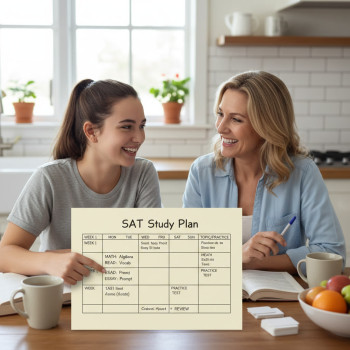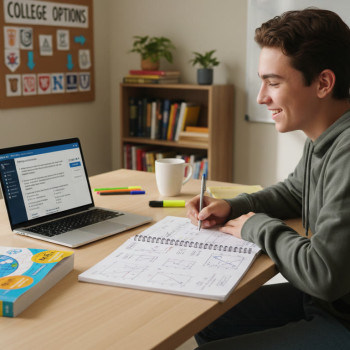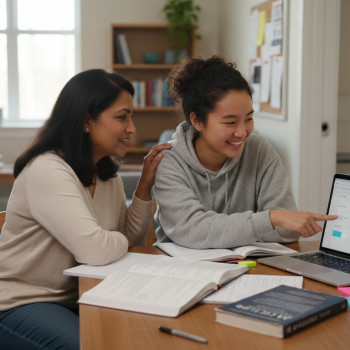Why this matters: the digital SAT, screens, and your teenager
The SAT went digital, and that shift changed more than file formats and testing apps. It changed how students interact with practice tools, timed sections, note-taking methods, and—crucially—how much time they spend with screens while preparing. For many families, the same device that opens practice tests also powers social apps, streaming, and homework. As a parent, you can’t (and shouldn’t) ban technology altogether, but you can help your student turn it into an ally: a focused, healthy tool that supports learning rather than a constant source of distraction or stress.

Start with empathy: understand the student’s world
Before setting rules, have a conversation. Ask about their study frustrations, what parts of prep feel useful, and where screens make focus hard. Teens respond better to collaboration than to edicts, and understanding their subjective experience makes any plan more likely to succeed.
- Ask open-ended questions: “When do you feel most distracted while studying?”
- Listen for patterns: time of day, certain apps, or types of tasks that trigger scrolling.
- Validate feelings: pressure around college admissions and test performance is real—acknowledging it lowers resistance.
Quick script to open the conversation
“I want to help you do your best on the Digital SAT—what tech habits feel like they help versus hurt? Let’s try one change this week and see how it goes.” A short, nonjudgmental script like this helps teens feel supported, not controlled.
Practical structure: routines and boundaries that work
Healthy technology use is mostly about structure. When studying for the Digital SAT, aim for intentional blocks, predictable breaks, and device-use rules that make the most of digital tools while minimizing mindless consumption.
Design a study rhythm (sample weekly plan)
Below is a compact plan you can adapt. The key: focused work, short breaks, and at least one offline activity daily.
| Day | Morning (60–90 min) | Afternoon (60 min) | Evening (30–45 min) |
|---|---|---|---|
| Monday | Targeted math practice (timed module) | Classwork / review errors (offline notes) | Light reading (paper book) |
| Tuesday | Reading comprehension strategies (digital passages) | Vocabulary review (flashcards) | Relaxing walk / screen-free time |
| Wednesday | Mixed practice tests (one section) | Review answers with parent/tutor | Stretch & unwind |
| Thursday | Essay-style practice or writing skills | Problem sets (math) | Social time with limited notifications |
| Friday | Timed practice + simulate testing environment | Score review and planning | Screen-free hobby |
| Weekend | Full practice test (one block) | Long-form review, rest | Family activity |
Concrete tools parents can set up
- Device settings: enable focus or do-not-disturb modes during study blocks; schedule them to make the routine low-friction.
- Notification triage: encourage students to silence social apps and keep only priority contacts available during study hours.
- Charging station: require devices to charge outside the bedroom overnight so sleep isn’t interrupted.
- Physical timer: for younger teens, visual timers (kitchen timers) reduce the urge to check the device.
Make the technology purposeful
Technology is most helpful when it has a clear purpose: practice, review, tracking progress. Aim to separate “study tech” from “leisure tech.”
Use digital tools intentionally
- Bluebook and practice apps: download official digital practice tests and have your student practice with the same interface they’ll use on test day.
- Focused practice playlists: create short playlists with ambient music to help concentration—no lyrics that compete with reading comprehension.
- Progress tracking: use a simple spreadsheet or app to log timed sections, accuracy, and topics missed. Seeing progress reduces anxiety.
When to go analog
Some tasks are best done on paper: handwriting notes, working through algebra step-by-step, or doing error analysis. Alternating between screen and paper helps memory and reduces screen fatigue.
Teach attention skills, not just test content
Focus is a skill that responds to training. Encourage strategies that strengthen attention over time.
- Pomodoro method: 25 minutes focused study, 5-minute break; after 4 cycles, take a longer break.
- Active recall: read a problem, close the device, and attempt it from memory on paper.
- Error logs: keep a notebook of recurring mistakes—this is cognitive scaffolding that’s independent of screen time.
Model healthy tech habits as a parent
Teens notice parental behavior. If you want them to have phone-free meals, try it yourself. If you want them to be calm before bed, dim screens an hour earlier for everyone.
Family agreements that actually work
Write a short, flexible family tech charter together. Keep it positive (what you’ll do) rather than punitive (what you’re banning). Include review checkpoints so the rules evolve with the student’s needs.
Balance practice with wellbeing: sleep, movement, and mental space
High-quality practice is only worthwhile when the brain is rested. Screen time right before bed interferes with sleep quality, which in turn affects memory and problem-solving.
- Sleep first: encourage consistent sleep schedules; prioritize 8–9 hours when possible.
- Movement: short exercise bursts between study blocks boost focus and mood.
- Mindfulness: two to five minutes of breathing or a quick grounding practice helps calm test anxiety before a timed module.
Navigating stress and motivation without demonizing tech
Students often use social apps to decompress. The goal is not to ban relaxation, but to channel it so it supports performance. Help your teen plan reward breaks that are genuinely restful—talking with friends, a favorite song, a quick walk—rather than doomscrolling through feeds.
Motivation tools that respect healthy limits
- Checkpoint rewards: small rewards after completing a focused block (e.g., 15 minutes of social time).
- Progress milestones: celebrate small wins publicly—mastering a question type or improving timing.
- External accountability: occasionally review practice logs together or with a tutor to maintain momentum.
Special considerations: accommodations, assistive tech, and equitable access
For many students, the digital SAT’s universal tools (zoom, line reader, built-in calculator) help—but some students need documented accommodations. If your child uses assistive technology at school, it’s essential to understand how those supports translate to the digital test environment.
- Plan early: accommodation approvals can take time; start the request process well before test day.
- Practice with the same setup: if your student will use a screen reader or particular assistive software, practice in the testing app so there are no surprises on test day.
- School coordinator: work with the school’s Services for Students with Disabilities (SSD) coordinator to ensure testing arrangements are in place.
How personalized tutoring can reduce tech overwhelm
One of the biggest benefits of personalized tutoring—such as Sparkl’s tailored 1-on-1 guidance—is that it reduces wasted screen time. Instead of aimlessly watching videos or scrolling through generic practice questions, students get targeted, efficient instruction focused on their weaknesses. A tutor helps interpret digital score reports, designs study plans that mix online practice with offline reinforcement, and models healthy study rhythms.
- Tailored study plans: tutors prioritize high-impact areas, shortening the total time spent online but improving outcomes.
- Expert tutors: they teach strategies for navigating digital tools like the Bluebook testing app so practice mirrors test conditions.
- AI-driven insights: when used, these can highlight specific question patterns or timing issues to address—again making screen time purposeful.
Practical checklist for parents: what to set up this week
Use this checklist as a practical jump-start. Small changes this week can compound into calmer, more effective prep over months.
- Create a visible study calendar with focused blocks and breaks.
- Set device focus schedules during core study hours.
- Establish a nightly charging routine outside the bedroom.
- Practice one official digital module together to understand the testing interface.
- Schedule a short check-in with a tutor (or Sparkl’s personalized session) to map priorities.
Common challenges and how to solve them
Below are a few scenarios parents commonly face and simple, practical responses.
Problem: The student keeps procrastinating with social apps
Solution: Replace “all or nothing” bans with tiny incentives. Try 25 minutes of focused work, then a scheduled 10-minute social break. Use an app-blocker only if agreed upon in advance and combined with a supportive check-in.
Problem: Device fatigue—student is exhausted from too many practice sections
Solution: Alternate digital practice with handwritten review. Do one timed digital section, then analyze errors on paper. Schedule at least one restorative, screen-free day each week.
Problem: Anxiety spikes before a full practice test
Solution: Normalize it. Run a short practice test in a calm setting, emphasize mastery of pacing (one module at a time), and use brief breathing or visualization exercises beforehand. Focus on learning from the test rather than on an absolute score.
Measuring progress: data without obsession
Numbers are useful when they guide improvement, but they become harmful when they dominate a teen’s identity. Help your student use scores to inform next steps, not to define self-worth.
| Metric | How to use it | When to worry |
|---|---|---|
| Section accuracy | Identify weak question types for focused practice | Accuracy consistently below target after repeated practice |
| Timing per question | Work on pacing strategies or timed drills | Student rushes or leaves many questions blank |
| Mood & energy | Adjust study load, schedule more sleep or movement | High anxiety or burnout over several weeks |
Celebrate process, not just results
Parents often wait for test day to express pride. Instead, celebrate process milestones: finishing a practice module with focused attention, improving timing, or building a consistent week of study. These wins encourage sustainable habits and make the student more resilient.
Final thoughts: you’re part coach, part calm
Helping your child prepare for the Digital SAT is a marathon of small choices. The most powerful thing you can do as a parent is provide steady structure, model balance, and prioritize your child’s wellbeing alongside academic goals. Technology will be part of the journey—embrace it when it helps, limit it when it distracts, and always pair it with human coaching and compassion.

If you want help getting started
Start small: pick one tech boundary and one study habit to try for two weeks. If your student needs targeted support, consider personalized tutoring: a tutor can create a study plan that mixes digital practice with offline reinforcement, model healthy pacing, and provide the one-on-one guidance students often need to translate practice into confidence. With structure, empathy, and the right help, the digital SAT can be a stepping stone—not a stressor—on the road to college.
Ready-made conversation starter
“Let’s try two weeks of this plan: study blocks with focus mode on, a short daily walk, and one weekly full practice section. We’ll check in every Sunday and adjust. Want to invite a tutor for one session to shape the plan?”
That simple invitation opens a path from overwhelm to action—and from action to progress.
You’ve got a kid who’s working hard. With thoughtful tech habits and the right supports, you can help them protect their focus, their sleep, and their joy—so that when test day comes, they’re ready in body, mind, and heart.












No Comments
Leave a comment Cancel